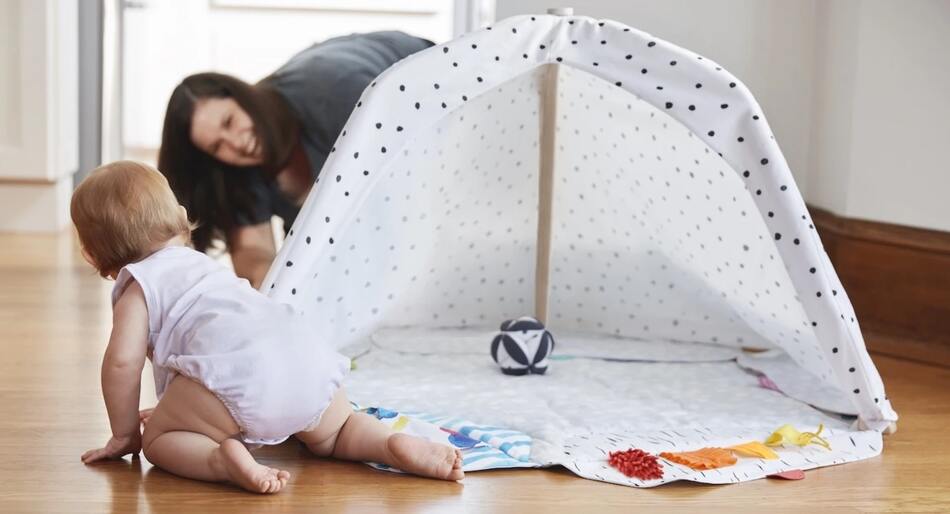During the time of the pandemic, children were absent from school, and parents worked from home, which led to many changes in the family’s daily routine. Parents will have more time to learn and play with their children. However, many parents will quickly feel “out of ideas” because they do not know what to play with their children or do not know how to start playing with their children happily or keep exciting and interesting activities. “Buying lots of toys” is not a good idea at this time. A small tip for parents at this time is to “have benefits from” all living things or anything children are fond of and turn it into an interesting toy. Like a blanket or a bedsheet, what can we play with?
1. Play with your child the “Peekaboo” game
This is a very simple and popular game that parents and children must have played together at least once in their lives. You can use a small blanket, a bedsheet, or a piece of cloth that is just the right size to cover your baby’s body entirely.

While playing with your child, you can exaggerate your facial expressions to be funny or silly to attract attention and stimulate your child to continue playing.
2. The “spring rolls” game
With this game, you hold the two ends of the blanket and stand on the opposite side of the child, paying attention to standing about 2 meters away from the child. You call your child’s name and announce the activity you are about to do (for example: Bear, I will make a vegetable spring roll now). When your child notices you, you will shout commands (e.g.: 1…2…3…roll spring rolls), then run over and hug your child with this blanket. You can lift your baby up a bit, hug him or rotate him slightly to increase the interest of the game and make him feel happier.
This is an activity that parents can play with their children every day to help strengthen family bonds.
Play with your child every day with the available blanket
3. The “Having fun in a hammock” game
You let the baby lie or sit in the middle of the blanket, the parents stand at the two ends of the blanket and start lifting the baby. Parents say the command “1…2…3…go” and then shake the blanket together. While playing, you can sing your child’s favorite song while looking him in the eye and showing that you care a lot. While playing, you can stop suddenly and wait to see if the child will respond such as: looking at you, asking you to continue. If your child shows that he wants to continue playing but can’t speak yet, guide him, such as “continue”, “swing”, “more” or “you want to continue playing”, “mommy swing again”, …
4. The “Up and down” game
One of the games with children is up and down. With this game you spread the blanket on the floor and let the baby lie in the middle of the blanket. You and an adult in the house, each person holds a blanket and reads the signal “1…2…3…up/down”. While playing, you can gently shake the blanket to make sudden changes to see how your baby responds. If your child smiles and shows interest, you can suggest that your child say something to show a demand, such as: “keep playing”. If your child is upset, you can guide her to express her feelings such as: “stop”, “I don’t like”, “I’m afraid”.
5. The “Going through the tunnel” game
If you have a large yard or garden, take your child outside and create a tunnel by covering other things with a blanket. You should find sturdy objects with medium-height (for example, a chair or table) and arrange them in two rows facing each other, then cover them with a blanket. You can guide your child to play continuous movement games such as: tunneling, overcoming obstacles to reach the finish line. Or you can instruct your child to push a car or bring a ball through the tunnel.
6. The “Camping” game
You set up a tent by fixing the 4 corners of the blanket or just get under the blanket and tell your child that you are going camping. In the tent, you should leave a few of your child’s favorite toys and play with them. You can also decorate your tent with your child by drawing or sticking small stickers on the tent. It will be great if you prepare a small table and a lazy pillow for your child to lie down or read a book. If possible, discuss with your child how the whole family will build the tent and guide your child from setting up the tent to when being able to sit in the tent to play.

Play with children in camping style
7. The “Racing Worm” Game
You spread the blanket on the floor and let your baby lie on the edge of the blanket. After counting “1…2…3…roll”, instruct your child to wrap himself in the blanket and try to crawl away. If your child doesn’t know how to do it yet, you can model and try to encourage your child to play along. This game is especially useful for children who need to seek feelings such as wanting to be hugged tightly.
8. Notes when playing with children
In order to bring fun and create excitement to play with children every day, parents should note the following issues:
- Follow your child: you can offer 2-3 activities for your child to let him or she choose. However, make sure this is the activity your child loves and wants to play.
- Equal to your child: equal in position (opposite, so that you and your child can easily see each other when playing) and equal in ability (play at your child’s level, ask for at your child’s level). the level your child can understand and speak.
- Have a play plan: prepare your tools well before starting playing since your child may run away or lose interest while waiting for you to find things. Having a play plan is also helpful when you want to introduce your child to a new play activity.
- Be flexible: be sensitive to all of your child’s “body sign” during play, for example: he’s distracted, he wants to run away from the activity. Some children won’t be able to stay at this action for a long time, accept that happily and go back to a watch-wait-listen and follow-up strategy. That’s why children only play and have fun when they play activities that they like.
- Don’t be afraid of the gaps: sometimes you will feel that: you have worked hard, but your child is still uncooperative and refuses to play with you. It’s okay, don’t be afraid of the gaps, you just think that it is the time when you give your child time to get used to the activity and also time for you to think of new play ideas with your child.
Parents, let’s turn the boring quarantine days into beautiful childhood memories of your children!












